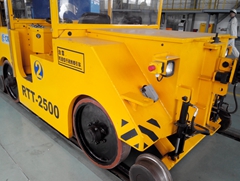Performance Comparison of Polyurethane Wheels and Rubber Wheels
 2.1
"Automatic loading vehicle field
2.1
"Automatic loading vehicle field
2.1.1 "Rolling resistance
The chemical composition of polyurethane material determines that it has a lower rolling resistance than rubber. Lower rolling resistance will improve the efficiency of electric automatic loading vehicles and reduce the number of battery charging. The more frequently the battery is charged, the labor for handling batteries will increase accordingly, and the lower the production efficiency. Therefore, it is best to use electric automatic loading vehicles. Use polyurethane wheels.
Rubber wheel manufacturers are also producing similar low rolling resistance wheels, using rubber formulations specifically designed for electric vehicles. These products are designed to reduce rolling resistance, improve battery life, and increase vehicle production efficiency.
2.1.2 "Cushioning performance
The cushioning capacity of a wheel is directly related to the hardness of its material. The higher the hardness value, the harder the wheel, the lower the ability to absorb impact energy, and the worse the cushioning performance. The Shore A hardness of rubber wheels is usually 67 to 75 degrees, while the hardness of polyurethane wheels is often as high as 83 to 95 degrees. Because urethane wheel are harder, the ride comfort is far inferior to rubber wheels for drivers of self-loading vehicles. When riding comfort is an important measure, changing to rubber wheels will improve significantly. If it is an electric vehicle, it is recommended to use a polyurethane elastomer material with a Shore A hardness of 83 degrees, so that the wheel has the largest bearing capacity and the smallest rolling resistance under the premise of ensuring the cushioning capacity.
When the Shore A hardness of polyurethane wheels is lower than 83 degrees, the physical properties decrease rapidly. The softer the polyurethane, the faster the decrease in toughness and load-carrying capacity. Over the years, in order to meet the demand for improved load-carrying capacity, polyurethane manufacturers have developed polyurethane formulations with a hardness of up to 95 degrees to improve wheel performance. Although this formula can bear a huge load, it can hardly provide shock absorption for the operator. Under normal circumstances, a urethane wheel with a hardness of 95 degrees has a 15% higher load-carrying capacity than a urethane wheel with a hardness of 83 degrees, which increases the tonnage of loading and unloading and reduces the downtime caused by replacing damaged wheels.










